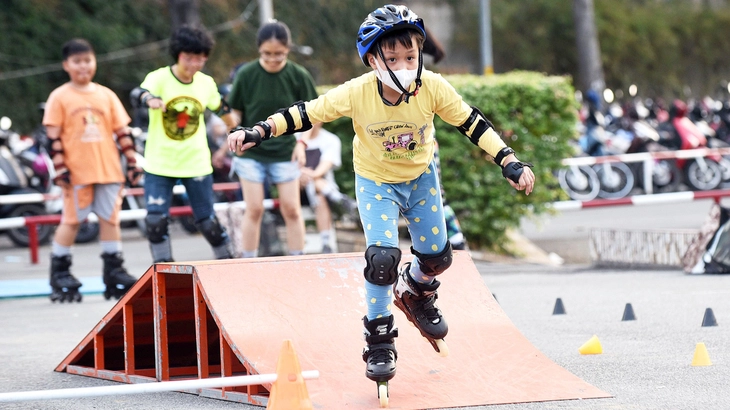
Children who exercise a lot and participate in sports help increase their height - Photo: DUYEN PHAN
Dr. Nguyen Ngoc Thuy Duong, Deputy Director of the City Center for Disease Control (HCDC), said that according to the results of a survey conducted by HCDC in the 2019-2020 school year on primary, secondary and high school students, the average height of boys and girls by class and age all increased compared to 10 years ago.
10 years increase 1 - 1.8 cm
The average height of 17-year-old males is 169.2cm, an increase of 1cm compared to 2009 (168.2cm); 17-year-old females is 157cm, an increase of 1.8cm compared to 2009 (155.2cm). This result is higher than the data from the 2018-2020 National Nutrition Survey (average height of 18-year-old males is 168.1cm and females is 156.2cm).
On April 19, 2024, the Ho Chi Minh City People's Committee issued Plan 2113 on implementing the National Nutrition Strategy in Ho Chi Minh City from now until 2030, including the target that by 2030, the average height of 18-year-old youth by gender will increase by 2 - 2.5cm for men and 1.52cm for women compared to 2020.
Some key solutions that contribute to improving stature include counseling, health check-ups, appropriate nutritional interventions, and vaccinations to prevent infectious diseases for women before and during pregnancy. Screening, diagnosis, and intervention during the fetal stage, treatment of some prenatal diseases; newborn screening to detect, intervene, and treat early congenital metabolic disorders, contributing to improving population quality.
The city also focuses on implementing nutritional interventions for children by instructing pregnant women, breastfeeding mothers and mothers with young children on proper nutrition, food safety, breastfeeding, knowledge to help form good habits to prevent school-related diseases, how to choose healthy and safe foods...
Organize school meals to ensure proper nutrition and periodically monitor children's growth and development to assess physical growth and provide appropriate nutritional interventions; supplement micronutrients for children, pregnant women and at-risk groups according to the Ministry of Health's protocol.
Dr. Duong commented that with the current average height of young people, in order for Ho Chi Minh City to achieve the goal of having young people as tall as other countries in the region by 2045, a long-term and comprehensive strategy is needed, requiring not only the efforts of the health sector but also investment and inter-sectoral coordination, thereby supporting children and families to form good nutritional habits and increase physical activity right from when they are still in school.
Need 1 hour of physical activity/day
According to the American Heart Association, children ages 3-5 are encouraged to be active throughout the day. Children ages 6-17 need 1 hour of moderate to vigorous physical activity per day. If your child has any physical limitations or underlying health problems such as asthma or arthritis, consult a health care professional before starting new activities.
Dr. Do Thi Ngoc Diep, former director of the Ho Chi Minh City Nutrition Center, said that physical activity is not only exercise but also playing, doing housework, moving around, and traveling.
The reality today is that many children go to secondary school but their parents still do not let them do housework. Most children are taken to school by motorbike or car, few children walk or ride a bicycle to school and walking or riding a bicycle is dangerous.
Extra classes also make students spend more time sitting in one place, reducing their time for physical activities, not to mention activities such as watching movies and playing games. The environment for sports activities is still limited: lack of schoolyards, parks, and practice areas for children, and large classes with few children participating in group activities. This needs to be changed, such as families playing and practicing together with children.
Dr. Vo Duy Linh, Department of Pediatric Orthopedics, Ho Chi Minh City Orthopedic Hospital, shares some ways to encourage children to exercise and move:
- The whole family should try to be physically active, set an example for their children, and inspire them instead of just asking them.
- Make exercise time fun and varied so that children look forward to exercising. You can add fun activities such as nature walks, outdoor games, swimming or group activities with friends and family.
- Create a stable schedule for your child including time for exercise, hygiene, sleep, rest, study and entertainment. This helps your child form a habit and consider exercise an essential part of life.
Source: https://tuoitre.vn/tang-chieu-cao-suc-ben-cho-tre-em-ky-2-lam-gi-de-thanh-nien-cao-hon-khoe-hon-20250527001117583.htm






![[Video] More than 100 universities announce tuition fees for the 2025–2026 academic year](https://vphoto.vietnam.vn/thumb/1200x675/vietnam/resource/IMAGE/2025/7/18/7eacdc721552429494cf919b3a65b42e)






















































































![[Infographic] In 2025, 47 products will achieve national OCOP](https://vphoto.vietnam.vn/thumb/402x226/vietnam/resource/IMAGE/2025/7/16/5d672398b0744db3ab920e05db8e5b7d)





Comment (0)